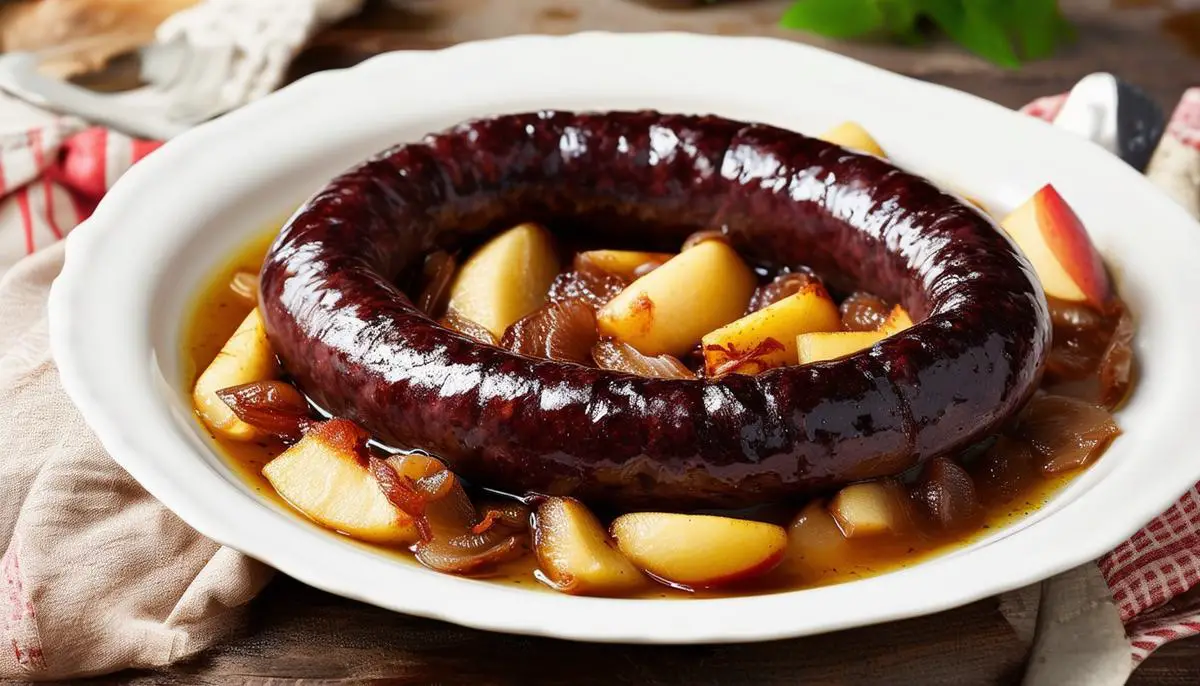Kishka: A Culinary Heritage Transcending Time
Originating in Eastern Europe, kishka, also known as stuffed derma, exemplifies the intersection of history, culture, and gastronomy within the Ashkenazi Jewish culinary tradition. This savory creation, traditionally involving a blend of matzo meal, rendered fat (often chicken), and an assortment of spices encased in a beef intestine, not only provided a way to utilize every part of an animal but also offered a hearty, flavorful component to meals, particularly on the Sabbath.
For the Jewish community with Polish ancestry, kishka represents more than mere sustenance; it's a symbol of heritage and communal feasts. Typically, it finds a prominent place in Shabbat cholent—a slow-cooked stew enjoyed by observant Jews on Saturdays. The presence of kishka in the cholent pot, slowly melding flavors with beans, potatoes, and meats, encapsulates the essence of Shabbat traditions, where preparation and anticipation culminate in a shared, restful meal.
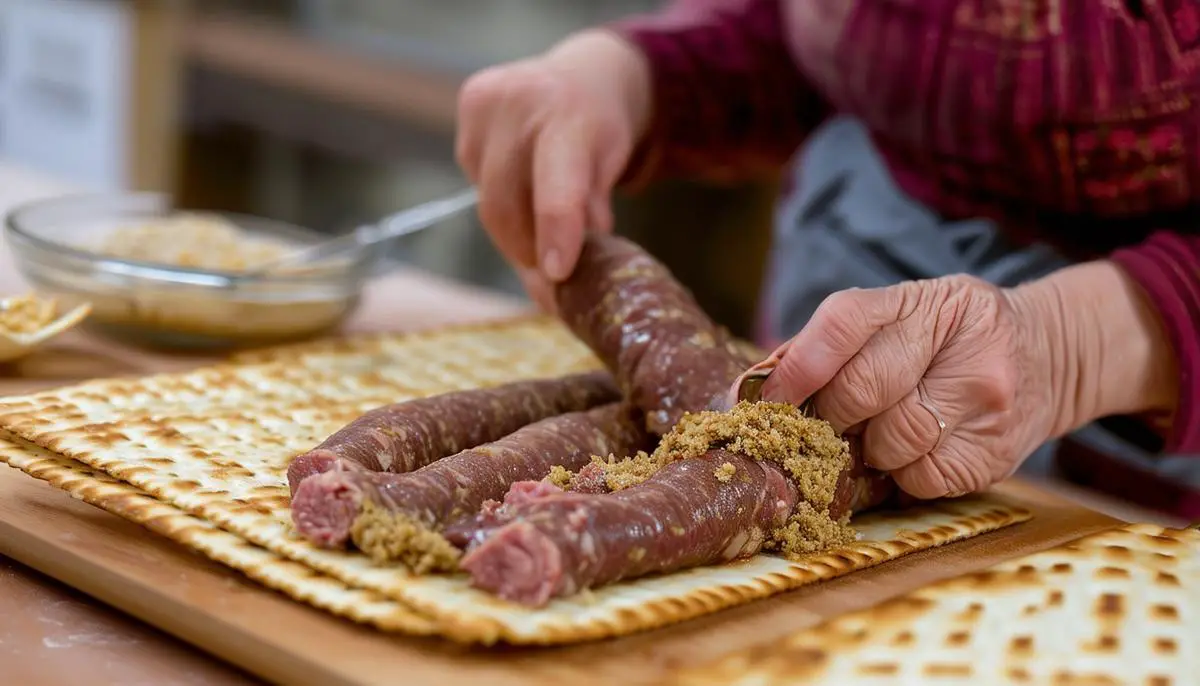
Traditional vs. Modern Kishka Recipes
The evolution of kishka recipes showcases a fascinating contrast between the traditional and modern approaches, reflecting changes in dietary preferences and culinary innovation. At its core, kishka is rooted in Ashkenazi Jewish heritage, traditionally involving a blend of matzo meal, fat, spices, and often encased in beef intestines.
Traditional Kishka centers around beef casings, incorporating ingredients like matzo meal, rendered fat (like chicken or beef fat), and spices such as paprika and black pepper. Modern versions have adapted to accommodate various dietary needs, including vegetarian and vegan preferences, often replacing beef casings with alternatives like parchment paper or aluminum foil. Instead of meat and animal fat, these recipes utilize vegetables, beans, and oils.
Ingredient differences are evident, with traditional kishka being meat-focused, while modern iterations emphasize plant-based ingredients like vegetables, legumes, and whole grains. Preparation methods also diverge, as traditional kishka involves stuffing and cooking beef casings, while modern recipes simplify the process by using parchment paper and foil, making it more accessible.
Health considerations play a role, as traditional kishka, with its use of beef casings and animal fats, often contains higher levels of saturated fat and cholesterol, contrasting with the lower-fat, fiber-rich options of modern vegetarian and vegan interpretations.
Preference often stems from cultural heritage and nostalgia for traditional kishka, evoking memories of Shabbat meals and communal gatherings. Modern versions attract those seeking plant-based alternatives, healthier options, or simply experimenting with new flavors and textures.

Ingredients and Preparation Tips
Creating both traditional and modern versions of kishka requires a blend of specific ingredients and careful preparation. Here are some essential ingredients for each version along with practical sourcing and preparation tips to help you achieve the best results.
Essential Ingredients:
Traditional Kishka:
- Beef casings (6 feet from a kosher butcher)
- Matzo meal (2 to 2½ cups)
- Beef or chicken fat (½ cup) or extra virgin olive oil
- Large onions (2)
- Carrots (4 medium)
- Paprika (1 teaspoon)
- Kosher salt (2 teaspoons)
- Freshly cracked black pepper (½ teaspoon)
Modern Kishka:
- Matzo meal (1 cup)
- Extra-virgin olive oil (3 tablespoons)
- Onion (½ medium to large)
- Garlic clove (1)
- Red bell pepper (1 large)
- Sweet potato (1 small)
- Smoked paprika (1 tablespoon)
- Cayenne pepper (1 teaspoon, optional)
- Kosher salt (½ teaspoon)
- Freshly ground black pepper (⅛ teaspoon)
- Black beans (½ cup)
Sourcing Ingredients:
Find kosher beef casings at specialty kosher butchers or online retailers. Matzo meal is available at most supermarkets, especially around Jewish holidays, or specialty stores carrying Jewish or kosher foods. For the freshest vegetables and spices, consider visiting local farmers' markets or organic grocery stores.
Preparation Tips:
Thoroughly rinse and soak beef casings before stuffing. Balance spices like paprika and black pepper based on personal taste. For modern versions, experiment with additional spices like smoked paprika to introduce new flavor profiles. Ensure vegetables are cleaned, peeled, and cut uniformly for even cooking. Roasting vegetables before blending can enhance their natural sweetness and deepen the overall flavor.
When assembling kishka, forming the mixture into a consistent log and wrapping it tightly with parchment paper and foil ensures an even bake and easy handling. If frying or slow-cooking in cholent, ensure the kishka is well-cooked but not overly dry.
For a complete meal, serve traditional kishka alongside cholent or roasted meats, while modern vegetarian kishka pairs well with fresh salads, roasted vegetables, or even as a unique burger topping.
Traditional Kishka Recipe:
Ingredients:
- 6 feet beef casings
- 2 cups matzo meal
- ½ cup rendered chicken fat or olive oil
- 2 large onions, diced
- 4 medium carrots, grated
- 1 teaspoon paprika
- 2 teaspoons kosher salt
- ½ teaspoon freshly cracked black pepper
Steps:
- Rinse and soak the beef casings in cold water for 30 minutes.
- In a skillet, sauté the onions and carrots in the rendered fat or olive oil until softened.
- In a large bowl, mix the matzo meal, sautéed vegetables, paprika, salt, and pepper.
- Stuff the beef casings with the matzo meal mixture, tying off the ends to form a long sausage-like shape.
- Place the stuffed kishka in a large pot of simmering water or cholent, and cook for 2-3 hours, until cooked through.
- Slice and serve hot, often with cholent or roasted meats.
Nutritional Information (per serving, based on 8 servings):
- Calories: 253 kcal
- Carbohydrates: 21g
- Protein: 8g
- Fat: 16g
- Saturated Fat: 5g
- Cholesterol: 24mg
- Sodium: 836mg
- Fiber: 2g

Common Cooking Techniques
Mastering conventional cooking methods is crucial for excelling in preparing kishka. Each technique imparts distinct textures and flavors, whether boiling, baking, or integrating into dishes like cholent.
Boiling:
The traditional approach of boiling is integral to recipes cooked in a cholent pot, allowing kishka to absorb the stew's flavors.
- Preparation: Wrap the uncooked kishka tightly in its casing or foil.
- Boiling: Submerge the kishka in boiling water or add it directly to the cholent pot with enough liquid for thorough cooking.
- Cooking Time: For cholent, simmer gently for 4-6 hours. In boiling water, cook a small to medium-sized kishka for at least 2 hours.
- Texture Management: Avoid vigorous boiling. A gentle simmer ensures the kishka absorbs flavors without becoming waterlogged or breaking apart.
Baking:
Baking offers a convenient method, achieving a firm texture and a slightly crisp exterior.
- Preparation: Preheat oven to 375°F (190°C). Wrap the kishka tightly in parchment paper and foil.
- Baking: Bake the wrapped kishka on a baking sheet for 1 hour.
- Cooling: Allow cooling for at least 30 minutes before unwrapping and slicing.
- Texture Management: Check for doneness by gently pressing the log; it should feel firm yet give slightly. If necessary, wrap tighter to maintain moisture.
Common Pitfalls:
- Overcooking: Overcooked kishka can become tough. Adhere to recommended times and monitor the texture.
- Inconsistent Heating: Ensure even heat distribution by simmering gently or positioning the baking sheet centrally.
- Dryness: Adjust the fat-to-dry ingredients ratio if the kishka seems dry. A bit more oil can help maintain moisture.
Kitchen Tools:
- Food Processor: Essential for mincing and mixing ingredients into a uniform paste.
- Parchment Paper and Foil: Vital for wrapping kishka to maintain shape and moisture.
- Thermometer: Useful to ensure inner temperature reaches at least 160°F (70°C).
- Slotted Spoon: Handy for removing kishka from boiling water without damaging its structure.
By following these precise cooking techniques, you can perfect traditional and modern kishka recipes, ensuring each preparation reflects both heritage and contemporary culinary standards.
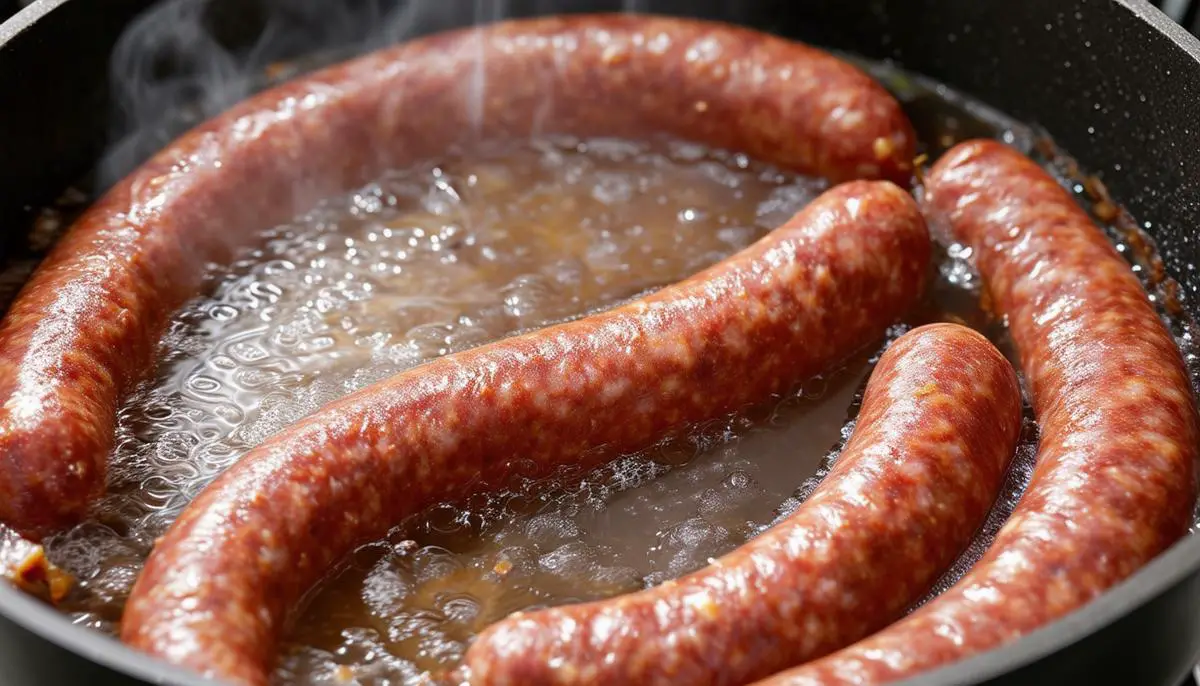
Serving Suggestions and Pairings
When serving kishka, consider complementing its rich, savory profile with other dishes for a well-rounded meal. Here are ideas to enhance your presentation and ensure it shines.
Kishka as a Side Dish:
- Israeli Salad: Tomatoes, cucumbers, and parsley in lemon juice and olive oil provide a bright contrast.
- Roasted Potatoes: Crispy, golden-brown potatoes seasoned with rosemary or thyme add a comforting element.
- Green Vegetable Medley: Lightly steamed or sautéed greens balance kishka's richness with fresh, crisp texture.
Kishka in a Stew:
- Cholent: Incorporate kishka into this traditional Jewish stew with beans, barley, potatoes, and meat. It absorbs the flavors, becoming sumptuous.
- Vegetarian Stews: Integrate vegetarian kishka into hearty vegetable and bean stews with rich broths.
Creative Serving Ideas:
- Stuffed Chicken Breast: Slice kishka and use as a stuffing for chicken breasts, served with greens.
- Burger Topping: Sauté sliced kishka and place on gourmet burgers for a flavorful twist.
- Gravy Pairing: Serve kishka with a thick, savory gravy for drizzling over mashed potatoes.
Complementary Beverages:
- Cold Polish Beer: A refreshing lager can cut through the richness, especially for Polish blood sausage variants.
- Apple Cider: Sweet acidity complements kishka's savory elements.
- Red Wine: A medium-bodied red wine, like Merlot or Pinot Noir, pairs well without overwhelming.
These suggestions cater to diverse preferences and dietary needs, ensuring kishka can be a versatile component in various culinary settings.
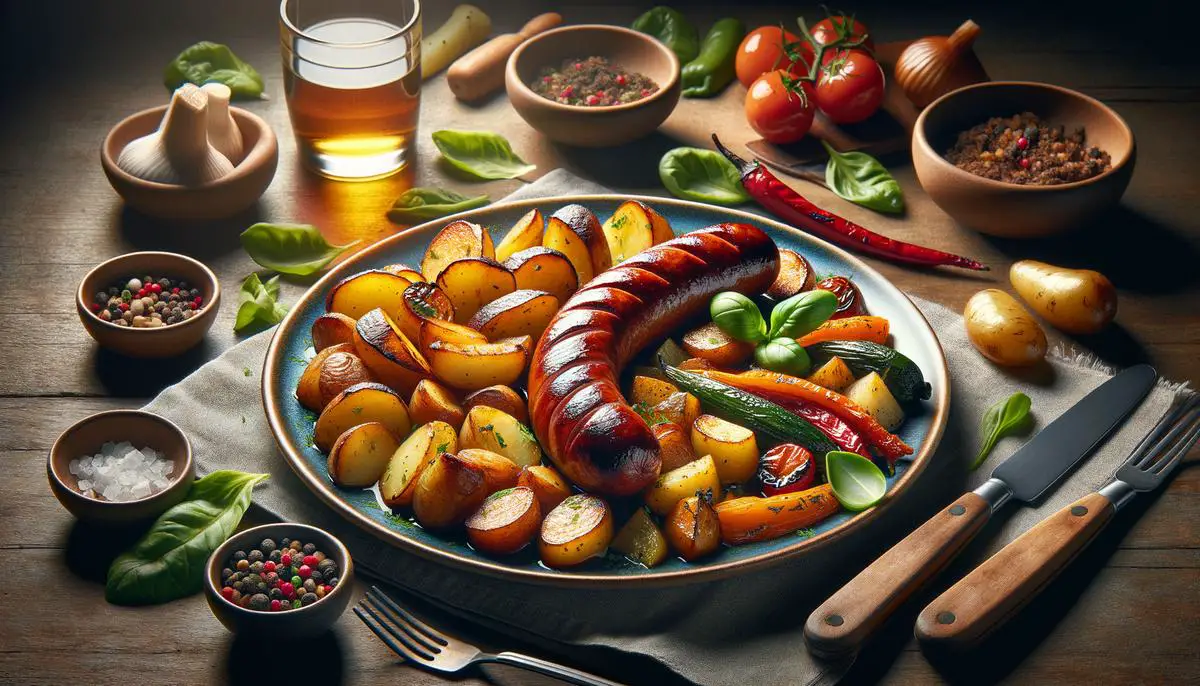
Recipe: Traditional Kishka
Ingredients:- 6 feet kosher beef casings
- 2 cups all-purpose flour, sifted
- 2/3 cup chicken fat, or extra virgin olive oil
- 1 medium onion, grated
- 2 1/2 tsp. kosher salt, divided
- 1/2 tsp. black pepper
- 1 tsp. paprika
- 1/2 cup grated carrots
- In a pot, heat salted water to cover the casings. Cut casings into 12-inch pieces. Sew up one end and turn inside out for each.
- Combine chicken fat, flour, 1 1/2 tsp. salt, pepper, carrots, onions, and paprika. Stuff each casing with the filling. Sew up the ends.
- Add to boiling water. Lower heat to low-medium. Cook for 10 minutes. Meanwhile, preheat oven to 325°F. Grease a large sheet pan.
- Remove from boiling water and drain. Place casings on sheet pan and bake for 2 hours. To serve, cut into 1-2 inch pieces.
Note: Kishka can be frozen. When defrosted, reheat in the oven, toaster, or microwave.
Nutritional information per serving:
- Calories: 330
- Total Fat: 18g
- Saturated Fat: 6g
- Cholesterol: 30mg
- Sodium: 890mg
- Total Carbohydrates: 30g
- Dietary Fiber: 2g
- Total Sugars: 2g
- Protein: 10g
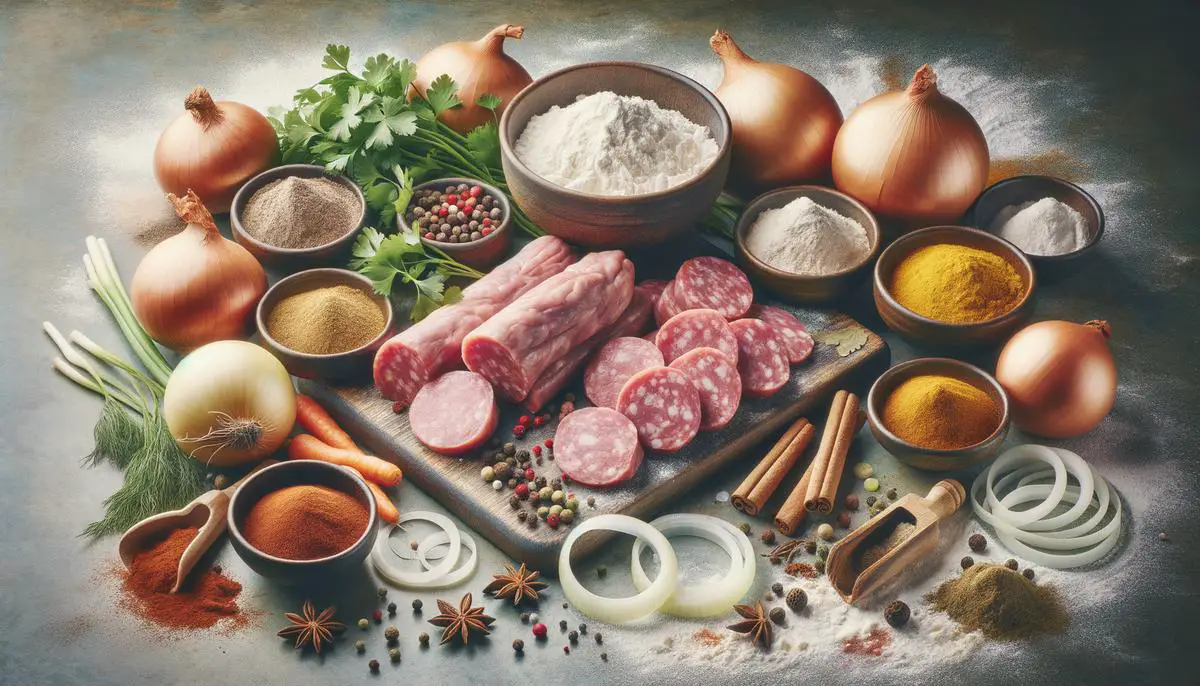
Recipe: Vegetarian Kishka
Ingredients:- 3 tablespoons extra-virgin olive oil
- ½ medium to large onion, cut into 1-inch pieces
- 1 clove garlic, chopped
- 1 large red bell pepper, cut into chunks
- 1 small sweet potato, peeled and cut into chunks
- 1 cup matzo meal
- 1 tablespoon smoked paprika
- 1 teaspoon cayenne pepper (optional)
- ½ teaspoon kosher salt, or to taste
- ⅛ teaspoon freshly ground black pepper, or to taste
- ½ cup black beans
- Preheat oven to 375°F (190°C).
- In a skillet, sauté the onion, garlic, red bell pepper, and sweet potato in olive oil until tender.
- Transfer the sautéed vegetables to a food processor. Add the matzo meal, spices, salt, pepper, and black beans. Pulse into a paste, adding a little olive oil if needed.
- Shape the mixture into a log on parchment paper. Wrap in parchment paper, then in foil.
- Bake for about an hour.
- Allow to cool for at least 30 minutes before unwrapping and slicing.
- Serve as a side or cook in a pot of cholent.
Nutritional information per serving:
- Calories: 250
- Total Fat: 10g
- Saturated Fat: 1.5g
- Cholesterol: 0mg
- Sodium: 300mg
- Total Carbohydrates: 35g
- Dietary Fiber: 5g
- Total Sugars: 4g
- Protein: 6g
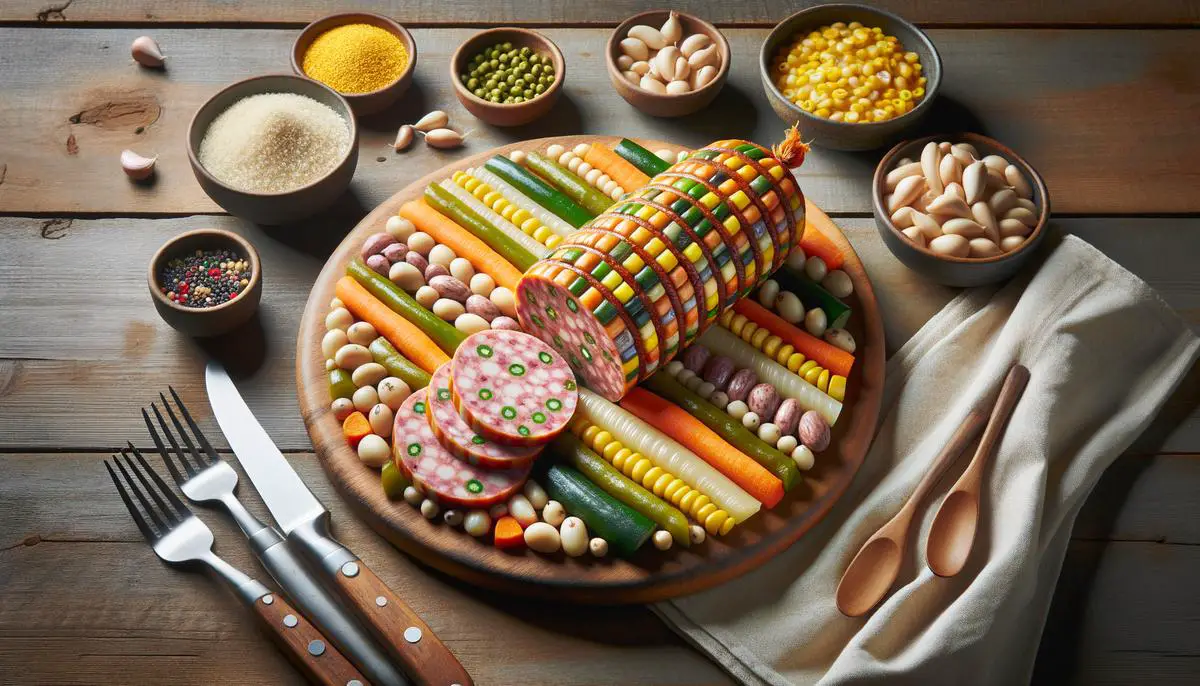
Recipe: Baked Kaszanka
Ingredients:- 3 blood sausage links (Polish Kishka, Kaszanka; approx. 6 in / 15 cm long; 1.5 in / 4 cm in diameter)
- 2 medium red onions, or 3 small ones
- 2 apples, or 3 small ones
- 1 tbsp butter
- Pinch of cumin powder
- 2 pinches ground cinnamon
- 2 pinches ground fennel
- 2 tbsp horseradish relish (optional)
- Preheat oven to 390°F (200°C).
- Slice onions into half-moons and apples into eighths.
- Sauté onions and apples with butter, cumin, cinnamon, and fennel for 3-4 minutes.
- Line an oven-proof dish with foil and spread horseradish relish at the bottom, if using.
- Layer one-third of the apple-onion mix, then blood sausage rounds, and remaining mix on top. Cover with foil.
- Bake for 20 minutes.
- Serve hot, optionally with bread, boiled potatoes, or sauerkraut.
Note: Check blood sausage labels for potential gluten content. Avoid sausages with additives or preservatives for best results.
Nutritional information per serving:
- Calories: 420
- Total Fat: 25g
- Saturated Fat: 9g
- Cholesterol: 65mg
- Sodium: 1100mg
- Total Carbohydrates: 40g
- Dietary Fiber: 5g
- Total Sugars: 15g
- Protein: 15g
